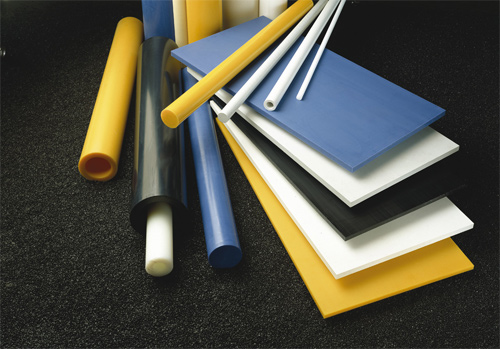High Performance

With the continual advancement in the manufacture of plastics, more and more materials are being developed which outperform the more common engineering plastics; amongst these items are:
EM42:
A highly flame retardant, halogen free, low smoke, low toxic epoxy laminate, approved by London Underground for use with all now rolling stock. It meets the requirements of UL94V0 fire rating.
PEEK (Polyetheretherketone, Victrex®):
This material has excellent chemical resistance, thermal stability and anti oxidisation properties, along with good mechanical strength, creep resistance and electrical properties. It can tolerate high energy radiation and is inherently fire retardant. PEEK has a wide operating temperature range from – 100°C to + 250°C
PEI (Polyetherimide, Ultem®):
A highly heat and flame resistant amorphous plastic, transparent amber in colour, PEI is able to operate at temperatures up to 170°C. It exhibits consistent dielectric properties over a wide frequency range and has good chemical and hydrolysis resistance. PEI is inherently flame retardant with low smoke emission. Because it is transparent to microwaves and can be used with foodstuffs, it has medical industry applications.
PES (Polyethersulphone):
A heat resistant amorphous material which is transparent yellow, PES has high tensile and flexural strength at temperatures approaching 180°C. It is tough and has excellent creep resistance. Its chemical resistance is also good. PES can be welded or chemically bonded. PES is resistant to X-Ray, Beta and Gamma radiation and can withstand repeated sterilisation/steam cleaning. It has good long term ageing properties but relatively poor tracking resistance
PETP (Polyethylene terephthalate, Arnite®):
Thermoplastic polyester is used as a possible replacement for die cast aluminium or zinc in motor housings, thermoset laminates in switchgear and other electrical applications. It withstands a broad range of chemicals at room temperature, has high creep resistance and low moisture absorption. PET offers the wear resistance of nylons and the dimensional stability of acetal. High strength and rigidity allow close tolerance machining. Grades of PET(P) have FDA and BGA approval for use in contact with foodstuffs.
PPE or PPO (Polyphenylene ether, also called Polyphenylene Oxide, Noryl®):
This material exhibits very low moisture absorption and good hydrolytic stability. Mechanically it is “stiff” and has good tensile and impact strength along with good resistance to creep under long term loading. Combined with high dielectric strength, PPE fulfils many electrical and electronic industry criteria over a wide range of humidity and temperatures from – 50°C to + 100°C
PPS (Polyphenylene Sulphide):
PPS offers the broadest resistance to chemicals of any advanced engineering plastic. It is not affected by any solvents below 392°F (200°C) and is inert to steam, fuels and acids. Minimal moisture absorption and a very low coefficient of linear thermal expansion, combined with stress-relieving manufacturing, make PPS ideally suited for precise tolerance machined components.
PSU (Polysulphone):
Transparent straw in colour, PSU has an operating temperature range of -40°C to +160°C with good mechanical strength, resistance to deformation under load, good impact and high frequency electrical properties. Resistant to acids, alkalis and hydrolysis, PSU also has excellent radiation stability, combined with the lowest ionic impurity levels available as a thermoplastic. It can withstand constant steam cleaning and grades are food contact approved
PVDF: (Polyvinylidene Fluoride, Kynar®, Solef®):
PVDF has many of the desirable corrosion resistant features of PTFE without its tendency to creep. It has superior chemical resistance to PVC and is capable of operating at temperatures in excess of 100°C. A combination of good mechanical strength, chemical inertness and electrical insulation enables it to be used widely in the pharmaceutical and food industries.
